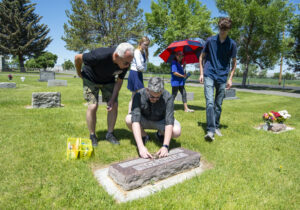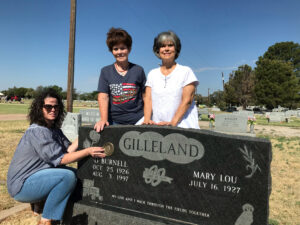
Although more than 1,000 miles and nearly 100 years apart, the graves of two more Carnegie heroes were marked this past Independence Day weekend (2022) with a bronze medallion honoring their extraordinary heroism thanks to research done by their descendants.
In Powell, Wyoming, the Reynolds family started researching their family tree during the COVID-19 lockdown, eventually discovering their ancestor Albert E. Johnson, who posthumously received the silver Carnegie Medal in 1911.
Despite warnings, Johnson, a 47-year-old farmer of Powell and father of seven children, insisted on being lowered to the bottom of a 50-foot well, where Frederick A. Herbaldsheimer, 28, had been overcome by gas and collapsed on Feb. 14, 1910, in Powell. With those gathered at the top of the well unable to see the activity at the well’s bottom, they hoisted the rope about 15 minutes later. Apparently, Johnson had untied the rope from his own body and tied it around Herbaldsheimer to be pulled to safety, but Herbaldsheimer died before he could be brought to safety. Johnson was later retrieved from the well, revived, but he also died that evening.
Only 617 silver medals were awarded by the Commission before the conclusion of the gold, silver, and bronze medal program in 1980. The Commission provided a monthly grant to Johnson’s widow and children until 1914. Johnson is buried in Crown Hill Cemetery in Powell.
The Reynolds – great, great, great grandson Jeremy Reynolds, his partner Kathy Coleman, and their children Ezekial and Trinity; and great, great grandson Don Reynolds and his wife Brenda – traveled about 110 miles from their hometown in Sheridan to Powell to mount the grave marker on Johnson’s headstone.
For them, discovering their ancestry in Wyoming validated why they feel drawn to the Cowboy State.
“Wyoming has always been my home. But it’s also in our DNA. It’s in our blood,” Don Reynolds told the Powell Tribune for a July 7 article.
“I’ve always felt at home in Wyoming,” Jeremy Reynolds added.

More than 1,000 miles away in Haskell, Texas, family of Carnegie Hero Burnell Gilleland placed a grave marker on his headstone located in Willow Cemetery.
“We just wanted to honor my dad with that on his headstone,” said Sheila Griffin, Gilleland’s daughter. “Whenever the grandkids return to visit they’ll be able to see it and remember the honor.”
Gilleland died in 1997 attempting to save his 23-year-old grandson from suffocation at the bottom of a water well. Griffin’s son, Walter H. McMeans, was helping his grandfather remove a pump from the well and lost consciousness inside. Gilleland immediately climbed into the well to try to remove McMeans, but also lost consciousness. According to the Hero Fund’s 1999 investigation, the family did not know that the well’s atmosphere had been contaminated by gas. Other family members summoned help, but by the time rescue workers removed the two men from the well, they could not be revived.
With Griffin in mounting the grave marker was her husband Luke, daughter Misty Gibson with her husband Paul and step-son Will, and sister Susan Blanks with her husband Terry.
Griffin said son-in-law Paul Gibson found out about the Hero Fund’s grave marker program through its website.
The Hero Fund offers grave markers to the families of Carnegie Medal recipients who have died. The 3.75-inch medallions are cast in the likeness of the Carnegie Medal and can be mounted onto a headstone or urn.
For more information, see the Commission’s grave marker page.

